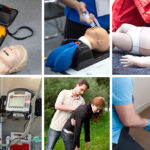Cardiopulmonary resuscitation is the first aid treatment given to a person when the heart stops also known as cardiac arrest. The brain needs oxygen to function and can only survive without it for five minutes after which the brain dies. Oxygen is delivered to various parts of the body and to the brain through the blood. The heart distributes blood to other parts of the body, and when the heart stops blood flow also stops. A brain can live for five minutes without oxygen. If this time passes it leads to brain damage. The person can be alive when the heart restarts but the brain would be dead. You can know more about this by taking the best CPR first aid online course.
What Happens During Cardiac Arrest?
Cardiac arrest is a natural phenomenon that leads to death. It could be anticipated due to the level of illness one has. Also, it can come suddenly when one has heart problems they may not know about. CPR may mostly be effective in the latter case than in the former.
Once the heart stops, one would lose consciousness and pass out. After which, they wouldn’t be aware of anything and this could lead to death.
If CPR is administered to the victim, they need to undergo treatment for the after-effects of this life-saving technique.
CPR is essential because in trying to restart the heart, oxygen via blood can get to your brain reducing the chances of brain damage.
Advantages and Disadvantages of CPR
Here are the advantages:
- CPR is a lifesaver when administered immediately on a healthy person when the heart stops.
- CPR, if done as soon as the heart stops, can ensure a higher chance of restarting it. In fact, it is useful if the victim has no serious illness prior to cardiac arrest.
Here are some drawbacks of CPR you need to know:
- If the victim is seriously ill or has a couple of illnesses, CPR may not be able to restart the victim’s heart. Soreness, broken ribs, lung collapse are all cons of CPR even after the victim survives.
- CPR is more effective when more than enough time has not passed before administration. Oxygen loss in some vital organs can lead to damage of such organs, foremost of which is the brain. More so, if there are other illnesses the person may not fully recover to his original state of health. Being on a respirator, depending on others for care, and also brain damage can happen. This can make it impossible to return to their former best.
- In view of these facts, there is a Do Not Resuscitate (DNR) order or Do Not Attempt to Resuscitate (DNAR). This can be given to inform health care professionals not to resuscitate the victim when they go into cardiac arrest. DNR doesn’t interfere with the quality of treatment that the victim would receive or other decisions made in the process.
Conclusion
It is essential to know more about CPR techniques by taking the CPR first aid online certification course to save lives when it matters.







